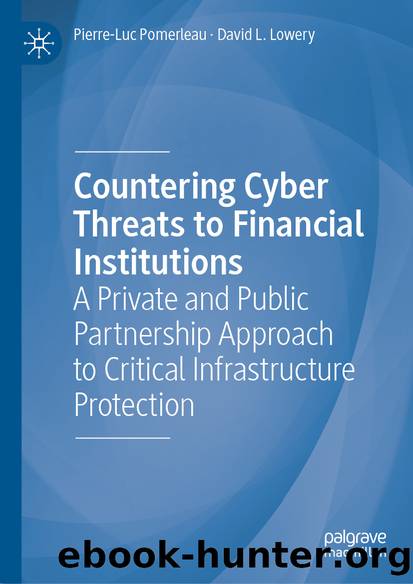Countering Cyber Threats to Financial Institutions by Pierre-Luc Pomerleau & David L. Lowery

Author:Pierre-Luc Pomerleau & David L. Lowery
Language: eng
Format: epub
ISBN: 9783030540548
Publisher: Springer International Publishing
Public Sector (Law Enforcement) and Government Roles and Responsibilities
The law enforcement role in publicâprivate partnership in information sharing is regularly associated with the deterrence of crime, the disruption of organized crime rings and the application of the law. Under the Criminal Code, law enforcement in Canada is mandated to investigate any types of criminal activities which may be committed online through the Internet or in the physical world (Public Safety Canada, 2017). The role of the government is to foster cybersecurity initiatives to explore innovative ways of making businesses and Canadians cyber secure (Public Safety Canada, 2018b).
According to the International Centre for the Prevention of Crime (2018), the primary motivations of the public sector in establishing private and public partnerships is to facilitate the implementation of a national cybersecurity strategy, to allow the private sector to participate in cybersecurity as well as providing a range of resources that are not available to the public sector. As Cesteros (2017) argues, funds available for public security are not enough to be able to fight cybercrimes. This situation leads to the private sector having to drive most initiatives and investigations affecting a private person or a private company (Cesteros, 2017).
The functioning and culture of the public sector differ in various ways, and the concept of threat and incident do not hold the same meaning for both sectors (International Centre for the Prevention of Crime, 2018). Maras (2017) states the intelligence community follows a bureaucratic model of operations structured with strict rules and procedures. Besides, contrary to the private sector, public authorities must inform the public which may be problematic for the private sector to maintain its reputation and customerâs trust when a private organization is victim of a cyberattack (International Centre for the Prevention of Crime, 2018). Due to these differences, the issues of dealing with cybercrime are perceived differently by the actors (Germano, 2014; International Centre for the Prevention of Crime, 2018).
Gendron and Rudnerâs (2012) study focuses specifically on Canada, and they provide many recommendations to the government on how to improve the protection of critical infrastructures through a proactive intelligence approach. From a public sectorâs landscape, the authors believe the major threats to Canadian critical infrastructures are international terrorism, state-sponsored espionage or sabotage, and hacktivism (Gendron & Rudner, 2012). They claim the existing defensive measures in place would not be enough to maintain the integrity and the availability of Canadian information systems and preventing attacks on the critical infrastructures (Gendron & Rudner, 2012).
Download
This site does not store any files on its server. We only index and link to content provided by other sites. Please contact the content providers to delete copyright contents if any and email us, we'll remove relevant links or contents immediately.
International Integration of the Brazilian Economy by Elias C. Grivoyannis(57324)
The Radium Girls by Kate Moore(10907)
Turbulence by E. J. Noyes(7039)
Nudge - Improving Decisions about Health, Wealth, and Happiness by Thaler Sunstein(6633)
The Black Swan by Nassim Nicholas Taleb(6192)
Pioneering Portfolio Management by David F. Swensen(5606)
Rich Dad Poor Dad by Robert T. Kiyosaki(5149)
Zero to One by Peter Thiel(4824)
Man-made Catastrophes and Risk Information Concealment by Dmitry Chernov & Didier Sornette(4736)
Secrecy World by Jake Bernstein(3783)
Millionaire: The Philanderer, Gambler, and Duelist Who Invented Modern Finance by Janet Gleeson(3569)
Skin in the Game by Nassim Nicholas Taleb(3461)
The Age of Surveillance Capitalism by Shoshana Zuboff(3423)
The Money Culture by Michael Lewis(3284)
Skin in the Game: Hidden Asymmetries in Daily Life by Nassim Nicholas Taleb(3264)
Bullshit Jobs by David Graeber(3180)
The Dhandho Investor by Mohnish Pabrai(3169)
The Wisdom of Finance by Mihir Desai(3079)
Blockchain Basics by Daniel Drescher(2891)
